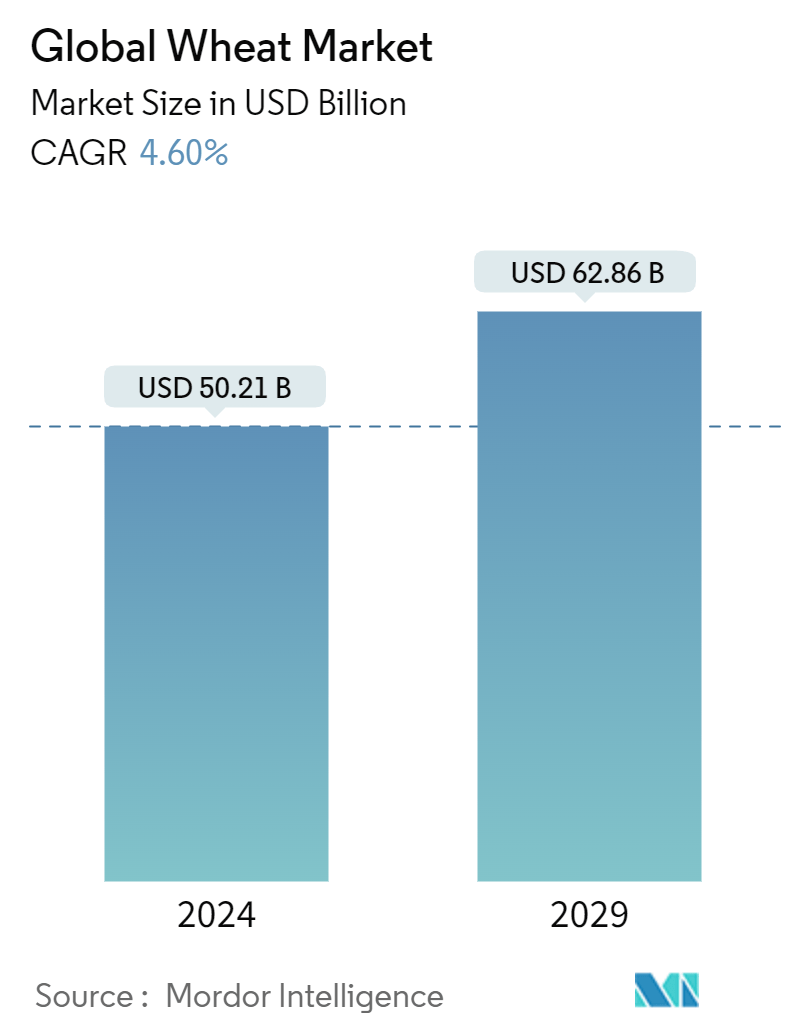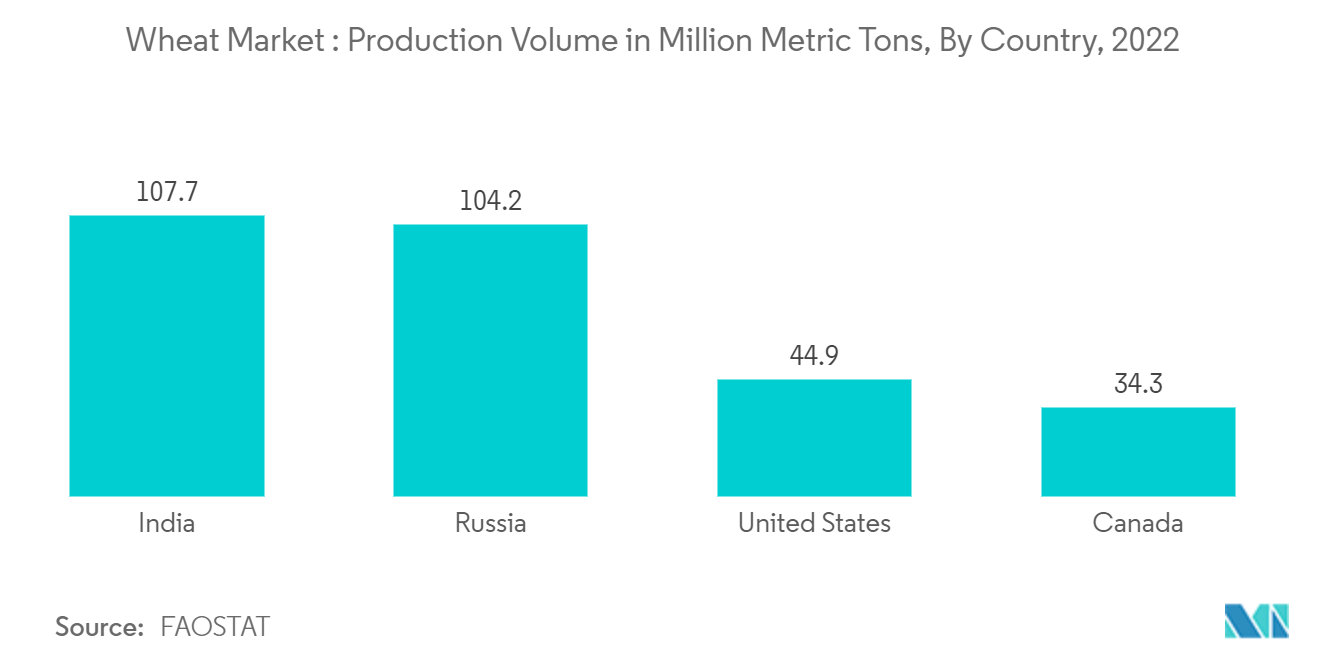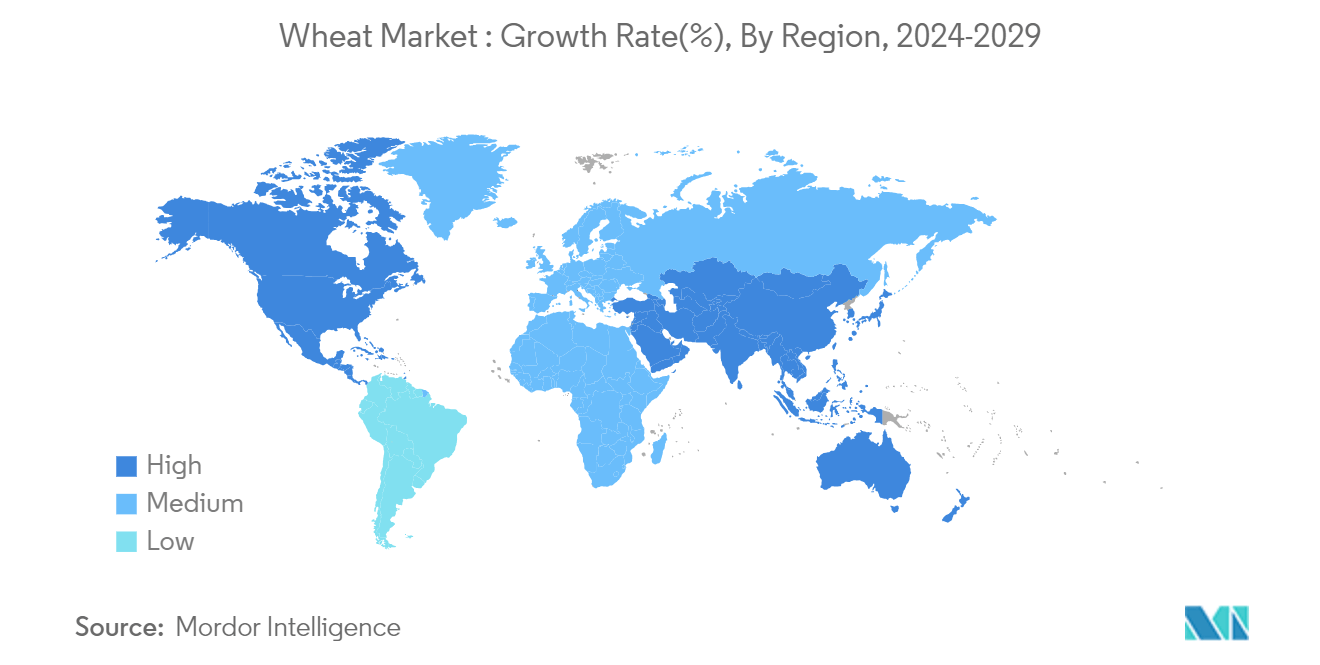Wheat Market Size

| Study Period | 2019 - 2029 |
| Market Size (2024) | USD 50.21 Billion |
| Market Size (2029) | USD 62.86 Billion |
| CAGR (2024 - 2029) | 4.60 % |
| Fastest Growing Market | Asia Pacific |
| Largest Market | Asia Pacific |
Major Players*Disclaimer: Major Players sorted in no particular order |
Wheat Market Analysis
The Global Wheat Market size is estimated at USD 50.21 billion in 2024, and is expected to reach USD 62.86 billion by 2029, growing at a CAGR of 4.60% during the forecast period (2024-2029).
Wheat is one of the most important cereal crops produced and traded globally. It is cultivated on a larger land area compared to any other cash crop globally. In terms of volume, global wheat production ranks third, following corn and rice. The total acreage used for wheat cultivation was 215.7 million hectares in 2019, increasing to 219.2 million hectares by 2022. Likewise, the production volume was 764.1 million metric tons in 2019, rising to 808.4 million metric tons in 2022.
Over the long term, the increased consumption of wheat across the countries in various cuisines and by the processing industries for the production of products like flour, pasta, noodles, and beverages and the rising food demand are expected to drive the wheat market during the study period. Wheat is a major staple crop in Asian countries, after rice. It is consumed as flour for bread and flatbread and is used to prepare noodles, pasta, etc. Further, wheat is purchased primarily for consumption and creating stocks as a buffer to be stored and used in critical cases. Stockpiling of wheat creates an intertemporal buffer against shortages during large wheat consumption periods or low production years across the world.
Factors like the increasing world population, increasing R&D, and increasing health consciousness would lead to increased wheat consumption across the world during the forecasted period. However, factors such as increased awareness of gluten allergies or sensitivity and weather uncertainties recorded in several parts of the world are expected to restrain the market's growth during the forecast period. In addition, droughts and climate change are significant threats to wheat production in countries such as Russia, Ukraine, and Kazakhstan (RUK) region and to global food security. Severe droughts have been significantly affecting wheat production in these regions, thus, understanding the impacts of droughts and climate change on the RUK’s grain production is essential for predicting its potential as a reliable grain supplier in the future.
Wheat Market Trends
Increasing Wheat Production
Wheat is one of the principal cereal grains produced and consumed globally. It covers a land area more than any other commercial crop and remains the most important grain food source for human consumption. In addition, wheat is the major source of carbohydrates in the diet of people from many countries, including Australia, most of Europe, Northern Asia, and Northern Africa. Most wheat is consumed within the country where it is produced, although roughly one-fifth of global annual production is exported.
The countries with the highest volumes of wheat production in 2020 were China (134.2 million metric tons), India (107.6 million metric tons), and Russia (85.9 million metric tons), together accounting for 43% of the global production. These countries were followed by the United States, Canada, France, Pakistan, Ukraine, Germany, Turkey, Argentina, and Australia, which accounted for a further 31.8%. These are some of the key factors that are driving the wheat market globally.
Further, France holds the top position as the primary cereal producer in the European Union. According to the International Grains Council (IGC), Germany's total grain production in 2022 reached 59.9 million metric tons, representing 22% of the EU's overall output. The state of Centre in France has the highest production of wheat, accounting for 16% of the total wheat supply, followed by Picardie, the second-largest producer of wheat, accounting for 10% of all the wheat produced in France. The wheat production in Germany for 2022 was estimated to be 34.7 million metric tons, which rose from the 2019 figure of 30.1 million metric tons.
Likewise, Canada is one of the largest wheat producers globally. Canadian wheat classes are categorized as Western Canadian or Eastern Canadian by the regions where the varieties are grown. The major regions of spring wheat production in Canada comprises the provinces of Alberta, Saskatchewan, and Manitoba. Canada Western Red Spring (CWRS) is a hard wheat with high protein content. It is the most widely grown wheat class in Western Canada, accounting for more than 60% of annual production. In addition, Canada is the world's leading producer and exporter of durum wheat. Canadian durum production occurs in Saskatchewan (81%) and Alberta (19%).

Asia-Pacific is the Fastest Growing Market
China, India, Australia, and Pakistan are the largest wheat producers in Asia-Pacific. As per the US Department of Agriculture (USDA), during 2021-2022, China was the leading consumer of wheat, with a consumption volume of 148.5 million metric tons, followed by India, with 104.3 million metric tons of wheat consumption during the same period. More than one-third of the population in the country consumes wheat in some way or another. However, the demand for wheat to produce bread, biscuits, and cakes in the country is insignificant, less than 10% of the total wheat consumption.
Moreover, China imports some high-grade wheat every year for use in bread and pastries, which are becoming increasingly popular in the various provinces of the country. Chinese-grown wheat is rarely suitable for making croissants and other Western delicacies that are not easily baked.
In India, wheat has been primarily used as flour for various preparations since prehistoric times. Indians mostly consume it in the form of bread called roti. Roti or chapati is an integral part of the Indian diet, especially in the northern regions. Additionally, the growth of the Indian wheat market is driven by the major progressive policies implemented by the government. These include a significant increase in minimum support price (MSP) and government procurement. For instance, the MSP of wheat for rabi crops 2023-24 was fixed at INR 2,125 (USD 25.73) per quintal, with an increase of INR 110 (USD 1.33) per quintal over the last year’s MSP during the rabi season. These factors have led to the rise in wheat production in recent years.
Apart from human consumption, wheat is also used as livestock feed. Recently, opportunities to incorporate sprouted wheat into animal rations have been explored after a wet Australian harvest in some areas in 2021-22, which resulted in sprouted crops. The Australian Export Grains Innovation Centre (AEGIC) supported Australian grain traders and international customers with technical information on using sprouted wheat for animal feed.

Wheat Market News
- June 2024: The Government of India imposed stock limits on wheat to prevent hoarding and unscrupulous speculation and to manage overall food security.
- October 2022: Biological nitrification inhibition (BNI) - wheat technology was introduced in India, which will aid in establishing nitrogen-efficient wheat production systems in India's Indo-Gangetic region.
- February 2022: Inari, the SEEDesign company, and InterGrain, a leading cereal breeding company in Australia, came together in a strategic collaboration to improve the yield potential of wheat, enhancing the crop's long-term viability in the rapidly increasingly variable climate.
Wheat Market Report - Table of Contents
1. INTRODUCTION
- 1.1 Study Assumptions and Market Definition
- 1.2 Scope of the Study
2. RESEARCH METHODOLOGY
3. EXECUTIVE SUMMARY
4. MARKET DYNAMICS
- 4.1 Market Overview
-
4.2 Market Drivers
- 4.2.1 Increased Production Across Countries
- 4.2.2 Increased Food Security Policy and Trade Initiatives
- 4.2.3 Rising Consumption Leads to Increased Imports
-
4.3 Market Restraints
- 4.3.1 Unfavorable Climate Hampering Crop Productivity
- 4.3.2 Declining Area Harvest Under Wheat
- 4.4 Value Chain Analysis
5. MARKET SEGMENTATION
-
5.1 Geography (Production Analysis by Volume, Consumption Analysis by Volume and Value, Import Market Analysis by Volume and Value, Export Market Analysis by Volume and Value, and Price Trend Analysis)
- 5.1.1 North America
- 5.1.1.1 United States
- 5.1.1.2 Canada
- 5.1.1.3 Mexico
- 5.1.2 Europe
- 5.1.2.1 United Kingdom
- 5.1.2.2 France
- 5.1.2.3 Germany
- 5.1.2.4 Russia
- 5.1.2.5 Ukraine
- 5.1.2.6 Italy
- 5.1.2.7 Spain
- 5.1.2.8 Romania
- 5.1.3 Asia-Pacific
- 5.1.3.1 India
- 5.1.3.2 China
- 5.1.3.3 Australia
- 5.1.3.4 Japan
- 5.1.3.5 South Korea
- 5.1.3.6 Pakistan
- 5.1.4 South America
- 5.1.4.1 Brazil
- 5.1.4.2 Argentina
- 5.1.5 Middle East and Africa
- 5.1.5.1 South Africa
- 5.1.5.2 Egypt
- 5.1.5.3 Nigeria
- 5.1.5.4 Turkey
- 5.1.5.5 Iran
- 5.1.5.6 Algeria
6. MARKET OPPORTUNITIES AND FUTURE TRENDS
** Subject To AvailablityWheat Industry Segmentation
Wheat is widely cultivated for its seed and cereal grain, which is a staple food worldwide. Many species of wheat together make up the genus Triticum, out of which the most widely grown is common wheat (Triticum aestivum).
The wheat market is segmented by geography (North America, Europe, Asia-Pacific, South America, and Middle East and Africa). The report includes production analysis (volume), consumption analysis (volume and value), import analysis (volume and value), export analysis (volume and value), and price trend analysis of the wheat market across the world. The report offers market estimation and forecasts in value (USD) and volume (metric tons).
| Geography (Production Analysis by Volume, Consumption Analysis by Volume and Value, Import Market Analysis by Volume and Value, Export Market Analysis by Volume and Value, and Price Trend Analysis) | North America | United States |
| Canada | ||
| Mexico | ||
| Geography (Production Analysis by Volume, Consumption Analysis by Volume and Value, Import Market Analysis by Volume and Value, Export Market Analysis by Volume and Value, and Price Trend Analysis) | Europe | United Kingdom |
| France | ||
| Germany | ||
| Russia | ||
| Ukraine | ||
| Italy | ||
| Spain | ||
| Romania | ||
| Geography (Production Analysis by Volume, Consumption Analysis by Volume and Value, Import Market Analysis by Volume and Value, Export Market Analysis by Volume and Value, and Price Trend Analysis) | Asia-Pacific | India |
| China | ||
| Australia | ||
| Japan | ||
| South Korea | ||
| Pakistan | ||
| Geography (Production Analysis by Volume, Consumption Analysis by Volume and Value, Import Market Analysis by Volume and Value, Export Market Analysis by Volume and Value, and Price Trend Analysis) | South America | Brazil |
| Argentina | ||
| Geography (Production Analysis by Volume, Consumption Analysis by Volume and Value, Import Market Analysis by Volume and Value, Export Market Analysis by Volume and Value, and Price Trend Analysis) | Middle East and Africa | South Africa |
| Egypt | ||
| Nigeria | ||
| Turkey | ||
| Iran | ||
| Algeria |
Wheat Market Research FAQs
How big is the Global Wheat Market?
The Global Wheat Market size is expected to reach USD 50.21 billion in 2024 and grow at a CAGR of 4.60% to reach USD 62.86 billion by 2029.
What is the current Global Wheat Market size?
In 2024, the Global Wheat Market size is expected to reach USD 50.21 billion.
Which is the fastest growing region in Global Wheat Market?
Asia Pacific is estimated to grow at the highest CAGR over the forecast period (2024-2029).
Which region has the biggest share in Global Wheat Market?
In 2024, the Asia Pacific accounts for the largest market share in Global Wheat Market.
What years does this Global Wheat Market cover, and what was the market size in 2023?
In 2023, the Global Wheat Market size was estimated at USD 47.90 billion. The report covers the Global Wheat Market historical market size for years: 2019, 2020, 2021, 2022 and 2023. The report also forecasts the Global Wheat Market size for years: 2024, 2025, 2026, 2027, 2028 and 2029.
Wheat Forecast Industry Report
Statistics for the 2024 Wheat Forecast market share, size and revenue growth rate, created by Mordor Intelligence™ Industry Reports. Wheat Forecast analysis includes a market forecast outlook to 2029 and historical overview. Get a sample of this industry analysis as a free report PDF download.



